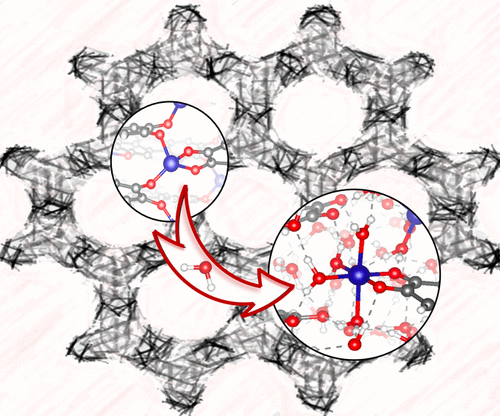当前位置:
X-MOL 学术
›
Chem. Mater.
›
论文详情
Our official English website, www.x-mol.net, welcomes your
feedback! (Note: you will need to create a separate account there.)
Water-Induced Structural Transformations in Flexible Two-Dimensional Layered Conductive Metal–Organic Frameworks
Chemistry of Materials ( IF 7.2 ) Pub Date : 2020-10-28 , DOI: 10.1021/acs.chemmater.0c03331 Yuliang Shi 1 , Mohammad R. Momeni 1 , Yen-Jui Chen 1 , Zeyu Zhang 1 , Farnaz A. Shakib 1
Chemistry of Materials ( IF 7.2 ) Pub Date : 2020-10-28 , DOI: 10.1021/acs.chemmater.0c03331 Yuliang Shi 1 , Mohammad R. Momeni 1 , Yen-Jui Chen 1 , Zeyu Zhang 1 , Farnaz A. Shakib 1
Affiliation

|
The flexible and ever-changing layered structure of electrically conductive 2D metal–organic frameworks (MOFs) poses a formidable challenge for establishing any structure–application relationship. Here, we employ a combined quantum mechanics and classical molecular dynamics approach allowing large-scale/long-time simulations of the dynamics of both dry and hydrated systems to investigate the intrinsic flexibility and dynamical motions of layered 2D MOFs and its effect on their physical and chemical properties. Co3(HHTP)2 and Cu3(HHTP)2, HHTP = 2,3,6,7,10,11-hexahydroxytriphenylene, MOFs as two representatives of the layered family of MOFs are studied in great detail with a focus on their experimentally observed differential framework stabilities in aqueous solutions. Our comprehensive molecular dynamics simulations reproduce structural properties of both MOFs as well as selective hydrolysis of the secondary building units with open metal sites in the hydrated Co3(HHTP)2 versus intact metal nodes in hydrated Cu3(HHTP)2 in agreement with available experimental reports. Our extensively detailed simulations reveal that the reason behind this behavior is the presence of intrinsic deformation sites in dry Co3(HHTP)2. Our accurate ωB97M-v quantum mechanical calculations further confirm the higher tendency of the open Co2+ sites for coordination to water molecules compared to Cu2+. Our multi-faceted strategy paves the way toward simulation of realistic MOF-based materials and their interface with confined water molecules, which is especially relevant to designing more robust water stable materials with desired properties and applications.
中文翻译:

二维柔性层状导电金属有机框架中的水诱导结构转变
导电二维金属有机框架(MOF)的灵活且不断变化的分层结构对建立任何结构与应用关系提出了巨大的挑战。在这里,我们采用结合了量子力学和经典分子动力学方法的方法,可以对干燥和水合系统的动力学进行大规模/长期模拟,以研究分层二维MOF的固有挠性和动力学运动及其对它们的物理和物理影响。化学性质。Co 3(HHTP)2和Cu 3(HHTP)2,HHTP = 2,3,6,7,10,11-六羟基三亚苯基,作为MOF层状家族的两个代表的MOF进行了详细研究,重点是它们在水溶液中实验观察到的差异构架稳定性。我们全面的分子动力学模拟重现了MOF的结构特性以及在水合Co 3(HHTP)2中具有开放金属位点的二级建筑单元相对于在水合Cu 3(HHTP)2中完整金属节点的选择性水解的能力实验报告。我们广泛详尽的模拟表明,此行为背后的原因是在干燥Co 3(HHTP)2中存在固有的变形位点。我们准确的ωB97M-v量子力学计算进一步证实了与Cu 2+相比,开放的Co 2+位点与水分子配位的趋势更高。我们的多方面策略为仿真基于MOF的逼真的材料及其与受限水分子的界面铺平了道路,这尤其与设计具有所需特性和应用的更坚固的水稳定性材料特别相关。
更新日期:2020-11-25
中文翻译:

二维柔性层状导电金属有机框架中的水诱导结构转变
导电二维金属有机框架(MOF)的灵活且不断变化的分层结构对建立任何结构与应用关系提出了巨大的挑战。在这里,我们采用结合了量子力学和经典分子动力学方法的方法,可以对干燥和水合系统的动力学进行大规模/长期模拟,以研究分层二维MOF的固有挠性和动力学运动及其对它们的物理和物理影响。化学性质。Co 3(HHTP)2和Cu 3(HHTP)2,HHTP = 2,3,6,7,10,11-六羟基三亚苯基,作为MOF层状家族的两个代表的MOF进行了详细研究,重点是它们在水溶液中实验观察到的差异构架稳定性。我们全面的分子动力学模拟重现了MOF的结构特性以及在水合Co 3(HHTP)2中具有开放金属位点的二级建筑单元相对于在水合Cu 3(HHTP)2中完整金属节点的选择性水解的能力实验报告。我们广泛详尽的模拟表明,此行为背后的原因是在干燥Co 3(HHTP)2中存在固有的变形位点。我们准确的ωB97M-v量子力学计算进一步证实了与Cu 2+相比,开放的Co 2+位点与水分子配位的趋势更高。我们的多方面策略为仿真基于MOF的逼真的材料及其与受限水分子的界面铺平了道路,这尤其与设计具有所需特性和应用的更坚固的水稳定性材料特别相关。











































 京公网安备 11010802027423号
京公网安备 11010802027423号